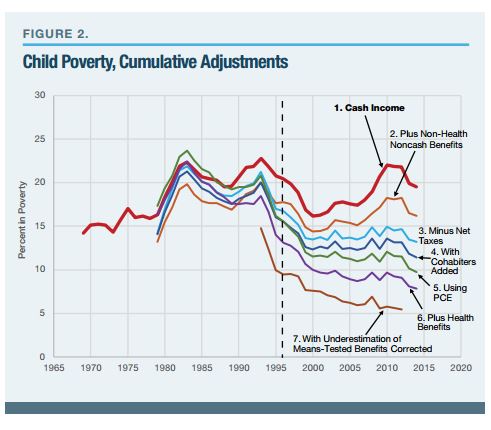This year marks the 20th anniversary of the landmark welfare reform that transformed antipoverty policy. The Personal Responsibility and Work Opportunity Reconciliation Act—known by the clumsy acronym PRWORA—was signed by President Bill Clinton on August 22, 1996, a couple of months before the presidential election.
Clinton’s decision to sign welfare reform into law divided the Democratic party. Two prominent members of his welfare policy team resigned in protest, and Democrats opposed to the Republican-written legislation issued apocalyptic predictions. The late senator Daniel Patrick Moynihan famously surmised that the new five-year time limit on eligibility for federal cash benefits “might put half a million children on the streets of New York in 10 years’ time.” Moynihan went on to lament: “We will wonder where they came from. We will say, ‘Why are these children sleeping on grates? Why are they being picked up in the morning frozen?’”
Related: As National Debt Hits $19 Trillion, a Spending Showdown Looms in Congress
The reality of poverty after welfare reform is not that portrayed by critics, according to a new report. Children—in particular, those in single-mother families—are significantly less likely to be poor today than they were before welfare reform. This is because income and poverty trends are poorly conveyed by official statistics and by most analyses of poverty data. Household surveys underestimate the cash income of these families and do not count as income a variety of valuable noncash benefits, including food stamps, housing subsidies, and Medicaid (the receipt and value of which are also underestimated). Meanwhile, the rise in the cost of living tends to be overestimated, pulling up poverty trends over time.
Reliable indicators do show increasing hardship in some years, but they mostly reflect the business cycle rather than a steady rise. To the extent that some less reliable measures of hardship appear to have worsened after 1996, they generally did so among groups of Americans (such as childless households, the elderly, children of married couples, and even married college graduates) who never received cash welfare under the AFDC program.
Child poverty overall fell between 1996 and 2014, after taking into account refundable tax credits and noncash benefits other than health coverage. After including household heads’ live-in romantic partners in the family (i.e., cohabitation) as well, child poverty was lower in 2014 than at any point since at least 1979. After also using the best available cost-of-living adjustment to update the poverty line and including health benefits as income, child poverty overall was lower by 5 percentage points in 2014 than in 1996 and is now at an all-time low. And after partially adjusting these estimates for the tendency of families to underreport government benefits, the child poverty rate in 2012 was just over 5 percent, compared with nearly 20 percent as indicated by the official poverty measure.
Related: Food Stamp Rolls Decline Sharply as Work Requirement Is Reinstated
What about “extreme” child poverty, defined as living on $2 or less per day? Extreme child poverty overall was the same in 2014 as in 1996—about one-half of one percent of children—once noncash government benefits and refundable tax credits are factored in. After correcting for underreporting of government benefits, in no year did the number of children in extreme poverty exceed one in 400. After correcting for underreporting, practically no children of single mothers were in extreme poverty in either 1996 or 2012. Fewer than one in 1,500 children of single mothers were in a household getting by on $2 a day per person for the whole year in 2012.
The question is not whether PRWORA was the single best welfare-reform policy that could have been imagined; policymaking never produces that result. The question is what would have happened in the absence of the welfare reform that we actually implemented.
Perhaps looser welfare policy would lower poverty in any given year but reduce upward mobility out of poverty—either over the course of childhood or once children become adults. More generally, to the extent that we reduce the cost of making poor decisions, more people will tend to make poor decisions. One does not have to believe that this logic demands that we eliminate all safety nets to acknowledge that these sorts of trade-offs are inevitable in designing welfare policy.
None of this is to say that TANF or other aspects of welfare policy cannot be improved or that our levels of deep poverty are sufficiently low. But policymakers should reject the increasingly conventional view that extreme poverty has dramatically increased and the view that welfare reform did more harm than good. Improving policy and reducing hardship require that we have a clearheaded view of our challenges.
This analysis was published originally in Economics21, a website of the Manhattan Institute.





